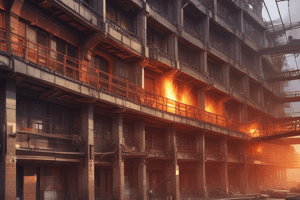Podcast
Questions and Answers
Which of the terms identifies a material applied to a structural element or system that provides increased fire resistance?
Which of the terms identifies a material applied to a structural element or system that provides increased fire resistance?
- Fire resistant (correct)
- Flame retardant
- Fireproof
- Fire retardant
Which term identifies a substance that helps delay or prevent combustion?
Which term identifies a substance that helps delay or prevent combustion?
- Fireproof
- Fire resistant
- Flame retardant
- Fire retardant (correct)
In what year was the first fire test of a fireproof floor assembly conducted by the Denver Equitable Building Company?
In what year was the first fire test of a fireproof floor assembly conducted by the Denver Equitable Building Company?
- 1896
- 1917
- 1890 (correct)
- 1904
The rated fire resistance is a quality ascribed to a wall, floor, or:
The rated fire resistance is a quality ascribed to a wall, floor, or:
Materials and assemblies may be classified based on their fire resistance, or, more accurately, based on their fire:
Materials and assemblies may be classified based on their fire resistance, or, more accurately, based on their fire:
Materials that have been tested and rated for fire resistance receive a rating that is based on which value?
Materials that have been tested and rated for fire resistance receive a rating that is based on which value?
A Class A flame spread rating is:
A Class A flame spread rating is:
A Class B flame spread rating is:
A Class B flame spread rating is:
The Standard Method of Test of Surface Burning Characteristics of Building Materials is:
The Standard Method of Test of Surface Burning Characteristics of Building Materials is:
Another name for NFPA's Standard Method of Test of Surface Burning Characteristics of Building Materials is:
Another name for NFPA's Standard Method of Test of Surface Burning Characteristics of Building Materials is:
There are two comparison points in evaluating test results. The flame spread over inorganic reinforced cement board is set at _____, and the flame spread over red oak is set at _____.
There are two comparison points in evaluating test results. The flame spread over inorganic reinforced cement board is set at _____, and the flame spread over red oak is set at _____.
A Class C rating flame spread index is:
A Class C rating flame spread index is:
In the FM Approvals corner test, the test walls are up to _____ feet high, the east wall is _____ feet long, and the south wall is over _____ feet long.
In the FM Approvals corner test, the test walls are up to _____ feet high, the east wall is _____ feet long, and the south wall is over _____ feet long.
The Radiant Flux Test of Floor Covering Systems (NFPA 253) measures a material's ability to resist:
The Radiant Flux Test of Floor Covering Systems (NFPA 253) measures a material's ability to resist:
The result derived from the Radiant Flux Test is known as the:
The result derived from the Radiant Flux Test is known as the:
Which of the following is used to limit the movement of smoke in the HVAC system of a building?
Which of the following is used to limit the movement of smoke in the HVAC system of a building?
Which method of closure is most common for fire doors?
Which method of closure is most common for fire doors?
Which of the following is a high priority for fire fighters when fighting a fire at a building with an activated sprinkler system?
Which of the following is a high priority for fire fighters when fighting a fire at a building with an activated sprinkler system?
Which class of standpipe systems uses a 'houseline,' which is intended for use by the occupants of the building?
Which class of standpipe systems uses a 'houseline,' which is intended for use by the occupants of the building?
There are two types of closure devices for fire doors: self-closing and:
There are two types of closure devices for fire doors: self-closing and:
Fire walls with automatic fire doors intended to close in case of fire are equipped with:
Fire walls with automatic fire doors intended to close in case of fire are equipped with:
Flashcards are hidden until you start studying
Study Notes
Fire Resistance Terms and Concepts
- Fire Resistant: Material that provides increased fire resistance to structural elements or systems.
- Fire Retardant: Substance designed to delay or prevent combustion.
- Fireproof: Indicates material that is resistant to fire effects, often misleading as no material is completely immune to fire.
- Flame Retardant: Similar to fire retardant, specifically formulated to resist flames.
Historical Context
- 1890: Year of the first fire test conducted for a fireproof floor assembly by the Denver Equitable Building Company.
Fire Resistance Ratings
- Rated fire resistance applies to structures like walls, floors, and columns.
- Classifications based on Endurance indicator of materials' fire resistance capabilities.
- Evaluation of fire resistance includes Hours of performance during testing.
Flame Spread Ratings
- Class A: Flame spread rating of 0-25.
- Class B: Flame spread rating of 26-75.
- Class C: Flame spread rating of 76-200.
Testing Standards
- NFPA 255: Recognized standard method for testing surface burning characteristics of building materials.
- Also known as ASTM E-84 or the Steiner tunnel test.
- Flame spread over inorganic reinforced cement board is set at 0, while red oak is set at 100.
Radiant Panel Flame Spread Test
- Measurement involves panels that are 20 × 24 inches.
FM Approvals Corner Test
- Walls can be up to 25 feet high, with the east wall measuring 50 feet and the south wall measuring over 37 feet.
Radiant Flux Test
- NFPA 253 assesses material's resistance to flame spread.
- Result is termed critical radiant flux.
Fire Safety Features
- Fire Dampers: Devices used to limit smoke movement in HVAC systems.
- Common closure methods for fire doors include Swinging doors, with automatic and self-closing variants available.
- Fusible links are installed in fire walls with automatic fire doors to enable closure in fire conditions.
Firefighter Protocols
- When dealing with buildings equipped with sprinkler systems, priority is to Supply the fire department connection.
Types of Standpipe Systems
- Class II standpipes utilize "houselines" meant for occupant use.
Automatic Fire Door Inspection
- Inspections should verify functioning and safety without neglecting measures like height of the operating door.
Studying That Suits You
Use AI to generate personalized quizzes and flashcards to suit your learning preferences.




